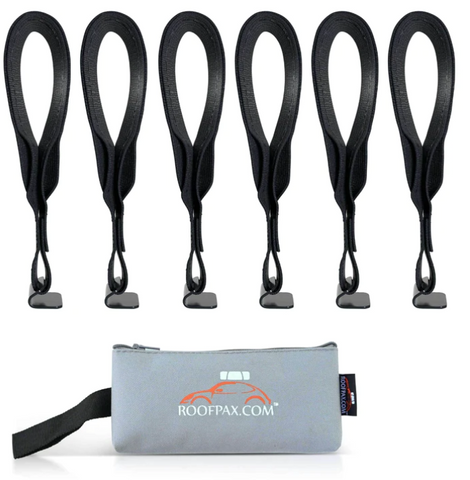How to Choose the Right Length and Strength for Roof Rack Tie-Down Straps

When it comes to securing your cargo on your car's roof rack, choosing the right tie-down straps is crucial. Without proper straps, your belongings may not be securely fastened, leading to potential damage or accidents on the road. In this comprehensive guide, we'll explore everything you need to know about selecting the appropriate length and strength for roof rack tie-down straps. Whether you're using a Buy Roofpax car top carrier bag or need to secure items directly onto your roof rack, understanding the different factors involved will ensure a safe and stress-free journey.
Understanding Tie-Down Straps: A Brief Overview
Before delving into the specifics of length and strength, it's essential to grasp the fundamentals of tie-down straps. These straps are versatile tools designed to secure various loads onto your roof rack. There are primarily two types of tie-downs: ratchet straps and rooftop cargo tie-down hook straps. Each type serves a specific purpose and provides distinct functions based on your needs. They come in various lengths, strengths, and configurations, catering to different types of loads and roof rack systems.
Types of Tie-Downs: Exploring Options
When shopping for tie-down straps, you'll encounter two primary types: ratchet straps and hook straps. Each type has its own set of advantages and is appropriate for different applications.

Ratchet Straps
Known for their robustness and adjustable mechanism, ratchet straps provide excellent tension control. This makes them ideal for securing heavy or irregularly shaped loads that require extra stability. The ratcheting mechanism enables you to tighten the strap with minimal effort, ensuring a secure hold.
Hook Straps
Hook straps, on the other hand, utilize hooks or loops at each end to secure the strap in place. These straps feature hooks at both ends, allowing for easy attachment to anchor points on your roof rack. They offer greater versatility in terms of attachment points, making them suitable for a wide range of cargo and roof rack configurations. Hook straps are quick and easy to use, making them a popular choice for everyday hauling needs.

Shop here: Cargo Tie Down Hook Straps
Choosing the Right Length Tie-Down Straps
Selecting the appropriate length of tie-down straps is equally important as their strength. Insufficient length may result in ineffective securing, while excess length can lead to tangling and reduced stability.
Determining Length Requirements Based on Load Type
When selecting tie-down straps, one of the first considerations is the length required to adequately secure your load. Different types of loads necessitate varying lengths of tie-down straps. For instance, a Car Top Carrier Bag might require longer straps to accommodate its bulk, while smaller items may suffice with shorter straps. Consider the dimensions and shape of your cargo when determining the appropriate length.
- Small Loads: For smaller items or cargo with minimal dimensions, shorter tie-down straps may suffice. However, ensure that there's enough length to securely fasten the load to your roof rack.
- Large Loads: Larger items or irregularly shaped cargo may require longer tie-down straps to accommodate their size and ensure proper securing.
Calculating Tie-Down Placement for Optimal Security
In addition to considering the length of the straps, it's essential to calculate the placement of tie-downs for optimal security. Distributing tie-downs evenly across your cargo helps prevent shifting during transit. This is particularly important for longer loads such as kayaks or surfboards. Utilize Roof Rack Soft Pads to protect your cargo and ensure a snug fit.
Strength Requirements for Tie-Down Straps
Different Levels of Strength in Tie-Down Straps
Tie-down straps come in various strength ratings, typically measured in pounds or kilograms. It's essential to match the strength of your tie-down straps with the weight and dimensions of your cargo. Overestimating or underestimating the required strength can compromise the security of your load and pose safety risks on the road.
Determining Required Strength for Your Load
To determine the required strength of tie-down straps for your load, consider the weight and dimensions of your cargo. Different types of tie-down straps offer varying weight capacities, typically ranging from a few hundred pounds to several thousand pounds. Ensure that the straps you select can safely support the weight of your cargo.

Determining the Number of Tie-Downs Required
The number of tie-down straps needed depends on the size and weight of your load, as well as the specific requirements outlined by manufacturers or transportation regulations.
Tailoring Tie-Down Quantity to Load Size
The number of tie-downs required for your load depends on its size and weight distribution. As a general rule of thumb, larger and heavier loads require more tie-downs to ensure stability and prevent shifting during transit. Let's explore how many tie-downs are needed for common load sizes:
- For a 10-foot load: At least four tie-downs should be used to secure the load adequately. Distribute the tie-downs evenly to maintain balance.
- For a 17-foot load: Increase the number of tie-downs to six or more to accommodate the larger size of the load. Ensure proper distribution for optimal security.
- For a 20-foot load: Similar to the 17-foot load, aim for six or more tie-downs to secure the load effectively. Pay close attention to weight distribution to prevent imbalance.
Ensuring Compatibility with Roof Rack Systems
Before purchasing tie-down straps, it's essential to ensure compatibility with your specific roof rack setup. Whether you have raised side rails or flush rails, choosing the right straps will optimize performance and safety.
Compatibility with Different Roof Rack Configurations
Compatibility with your roof rack system is another crucial factor to consider when choosing tie-down straps. Whether you have raised side rails, flush rails, or a specialized roof rack, ensure that the straps you select are compatible with your setup. Certain roof rack systems may require specific attachment points or adapters for optimal functionality.
- Roof Rack for Raised Side Rails: When using a roof rack designed for raised side rails, opt for tie-down straps that can easily loop around or attach to these rails securely.
- Roof Rack for Flush Rails: For vehicles equipped with flush rails, look for tie-down straps that can be anchored directly to these rails or utilize specialized adapters for a secure fit.

Utilizing Roof Rack Soft Pads for Added Protection
To protect both your cargo and your roof rack, consider using Roof Rack Soft Pads in conjunction with your tie-down straps. These soft pads provide a cushioned barrier between your load and the roof rack, reducing the risk of scratches or damage during transit. They also help distribute pressure evenly, further enhancing the security of your cargo.
In Summary
Selecting the right length and strength for roof rack tie-down straps is essential for safely securing your cargo during transit. By considering factors such as load type, strength requirements, tie-down placement, and compatibility with your roof rack system, you can ensure a secure and stress-free hauling experience. Whether you're embarking on a cross-country road trip or simply running errands around town, investing in high- quality tie-down straps from BuyRoofPax is a wise decision to protect your cargo and enhance road safety. Depending on your preference and the nature of your cargo, choose the type of tie-down straps that best suits your requirements. Remember, when it comes to transporting your belongings, safety always comes first.
Frequently Asked Questions (FAQs): Right Length and Strength for Roof Rack Tie-Down Straps
How do I determine the required strength of tie-down straps for my load?
To determine the required strength, consider the weight and dimensions of your cargo. Different tie-down straps come with varying weight capacities, so match the strength rating with the weight of your load. For heavier loads, opt for tie-down straps with higher strength ratings to ensure secure transportation.
What is the significance of distributing tie-downs evenly across my cargo?
Distributing tie-downs evenly helps prevent shifting during transit, ensuring the stability and safety of your load. This is particularly important for longer or irregularly shaped items. Proper distribution of tie-downs minimizes the risk of accidents and damage to your cargo or vehicle.
How many tie-downs are required for different load sizes?
The number of tie-downs needed varies depending on the size and weight of your load. As a general guideline:
- For a 10-foot load, at least four tie-downs should be used.
- For a 17-foot load, aim for six or more tie-downs.
- For a 20-foot load, utilize six or more tie-downs to ensure proper security. Always distribute tie-downs evenly for optimal stability.
Are tie-down straps compatible with different types of roof rack systems?
Yes, tie-down straps are designed to be compatible with various roof rack configurations, including raised side rails and flush rails. Ensure that the straps you choose can loop around or attach securely to your specific roof rack setup. Some roof rack systems may require adapters or specialized attachment points for compatibility.
How can Roof Rack Soft Pads enhance the performance of tie-down straps?
Roof Rack Soft Pads provide added protection for both your cargo and your roof rack. By cushioning the contact points between the load and the roof rack, they reduce the risk of scratches or damage during transit. Additionally, Roof Rack Soft Pads help distribute pressure evenly, improving the overall security of your cargo.
What are the advantages of using ratchet straps over hook straps, and vice versa?
Ratchet straps offer excellent tension control and are ideal for securing heavy or irregularly shaped loads. The ratcheting mechanism allows for easy tightening, ensuring a secure hold. On the other hand, hook straps provide versatility and are quick to use, making them suitable for a wide range of cargo and roof rack configurations. Choose the type of strap based on your specific needs and preferences.




